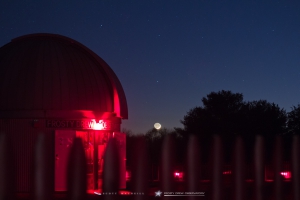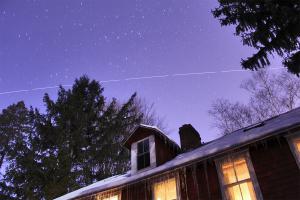
Stargazing Nights
- Where:
- Frosty Drew Observatory
- When:
- Friday December 2, 2016 at 6:00 p.m.
- Cost:
- $1 Suggested Donation per Person
Tonight is Stargazing Night at Frosty Drew Observatory and we may be in for an excellent night of clear, dark skies! Forecasts are calling for a quick bout of passing clouds around sunset, followed by mostly clear to clear skies for the entire night. There is a degree of variability in tonight’s forecast regarding the wind, which may be moderate at times with the potential for gusts to reach into the 30mph range. We’ll monitor wind conditions as the night progresses and, if necessary, we will restrict our views to the east and south skies. Though the wind may be problematic; the beautiful, super thin, 9% waxing crescent Moon will bring spectacular views and an early moonset, lining us up for a stunning night.
We will open the Observatory and Sky Theatre at 6:00 p.m. In the Observatory, telescopes will start off the night with a view of Venus and the crescent Moon in conjunction. After which, we will direct our telescopes toward many fabulous objects only visible on the darkest nights. Nebulae, star clusters, galaxies, and binary stars will rock our views. The Sky Theatre will feature warm temps for quick breaks from the cold alongside our popular showcase of celestial objects photographed at Frosty Drew Observatory. We will stay open until high winds shut us down or midnight swings around, whichever comes first. Though we may stay on site much later as we get lost in the fabulous starscape. Following us on Twitter or Facebook will get you updates from the Observatory, including a “Closing up” post when we decide to pack it up for the night.
Overall, tonight looks amazing. We can expect some wind and it could get a little blustery, though we will manage it the best we can. Temps will descend into the 30’s overnight, and the wind will make it feel MUCH colder. Dressing properly will not only make the difference between a cold night out and an amazing astronomy experience, it will also keep our telescope views in focus. Heat rising from your body will escape the dome through the opening in the roof, right past our telescope. Hat, gloves, wind resistant parka, and winter shoes or boots will all be necessary. Now make plans to set out for the darkest skies in Rhode Island and add to your Holiday cheer with thousands of stars blazing the cosmic expanse.
-------------------------------------------------------------------------
Weekly Happenings
Scott MacNeill
Don’t miss out on two beautiful celestial dances in the evening sky this weekend, compliments of the crescent Moon. The first view will happen tonight with a fabulous conjunction of the 9% waxing crescent Moon and Venus. The conjunction will appear shortly after sunset and will become quite visible once twilight starts to wane. Venus, the third brightest object in the sky, will shine like a super bright star, almost mistakable for an airplane in the southwest sky. The thin crescent Moon will be sitting about 8° northward from Venus. Since the Moon is only 9% full, Earthshine will become exceedingly visible as it gets darker out. Earthshine is when sunlight reflecting off Earth will illuminate the shadow side of the Moon, making it visible. Set out tonight about 30 minutes after sunset and look to the west for a view of Venus and the crescent Moon putting on their celestial dance. The second conjunction of the weekend will happen on Sunday night, December 4th, and will involve the 24% crescent Moon and Mars. Becoming visible after sunset, the crescent Moon will hang in the southwest sky just under 6° north of Mars. This conjunction will be easier to spot because it will last longer into the night and involves a brighter lunar phase. These are just a couple of many amazing conjunctions happening this winter. Keep an eye out for the crescent Moon sneaking in on Venus, Mars, and Jupiter over the next few months. If you catch a conjunction photo, post it on our Facebook and we will share it to our time line. Happy viewing!
This past Monday, November 28th, the International Space Station (ISS) has visibly returned to the evening sky over much of the USA. Bringing a few fabulous spotting opportunities to the New England skies this weekend. The best pass of tonight will happen at 5:00 p.m. and last for almost six minutes. Starting in the south-southwest sky, the ISS will rise to 38° on an easterly heading. A second pass will happen tonight at 6:37 p.m. lasting about 1.5 minutes, starting in the west, the ISS will rise to 23° before passing into Earth’s shadow and out of our sight. Tomorrow night will bring an even better pass at 5:44 p.m. lasting 4.5 minutes. Starting in the west-southwest sky, the Station will rise to 47° on a northerly heading. Then Sunday night will rock your socks with a stunning overhead pass of the ISS starting at 4:52 p.m. This pass will last almost seven minutes in duration and will start in the southwest sky, passing almost directly overhead, then into the northwest sky. Nightly passes of the ISS will continue every night until December 22nd, making for a great addition to the Holiday Season. Take a moment to read up on the ISS and why we see it periodically throughout the year. Then check in regularly on the Frosty Drew Observatory page for nightly pass information. If outside of the Southern New England area, visit NASAs Spot the Station for pass times applicable to your location. Since you will already be outside viewing the fabulous conjunctions of the crescent Moon with Venus and Mars this weekend, add in a view of the ISS passing and make it a true geeks night out!
-Scott


